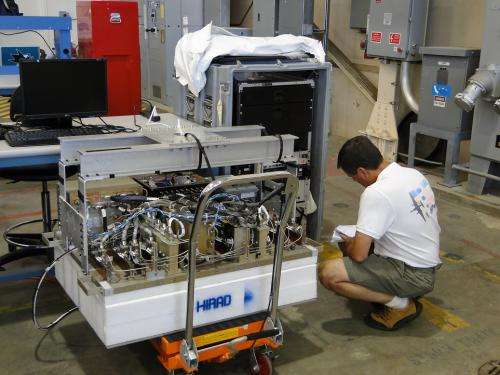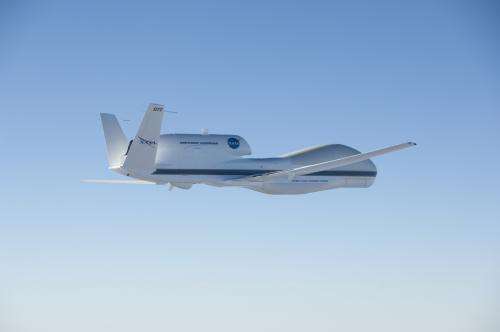HIRAD set to fly on Global Hawk mission

(Phys.org)—NASA has begun its latest airborne hurricane study called the Hurricane and Severe Storm Sentinel (HS3) mission. For the first time, NASA will be flying two unmanned Global Hawks, unmanned aerial vehicles, from the U.S. East Coast to understand the processes which underlie hurricane formation and intensity change.
The Hurricane Imaging Radiometer (HIRAD), an instrument developed at the Marshall Space Flight Center, is scheduled to fly aboard the second Global Hawk. HIRAD will measure surface wind speeds and rain rates using its rectangular antenna to track activity on the ocean's surface. The antenna measures microwaves emitted by the ocean surface that are increased by the storm. As winds move across the surface of the sea they generate white, frothy foam. This sea foam causes the ocean surface to emit increasingly large amounts of microwave radiation, similar in frequency or wavelength, but lower intensity, to that generated within a typical home microwave oven. HIRAD measures that microwave energy and, in doing so, allows scientists to deduce how powerfully the wind is blowing. With HIRAD's unique capabilities, the two-dimensional structure of the surface wind field can be much more accurately determined than current operational capabilities allow.
Global Hawks are unmanned aerial vehicles that can stay in the air for as long as 31hours and fly over hurricanes at altitudes greater than 60,000 feet. They are operated by pilots in ground control stations at Wallops Island, Va., and Dryden Flight Research Center at Edwards Air Force Base, Calif. NASA has been using these vehicles in scientific field campaigns since 2010.

The first phase of the study began Sept. 11 and investigated the environment in and around Tropical Storm Nadine. Phase two begins when a second Global Hawk begins flights later this month to look at the internal structure of developing and mature storms. Combined, the two aircraft use a unique set of instruments which measure wind, temperature, water vapor, precipitation and aerosols from the surface through the troposphere. Using the information provided by HIRAD, along with other data collected by instruments in the field campaign, scientists can construct a more complete and detailed representation of the hurricane.
"We receive lots of pieces of information to figure out what's happening inside the storm," said Dr. Tim Miller, HIRAD principal investigator and atmospheric scientist at the Marshall Center. "We combine HIRAD's data with information from weather balloons, weather satellites and other aircraft instruments, we put it all together using a process called data assimilation, and we hope to better predict how a hurricane will behave."
This is the second field campaign in which HIRAD has participated. HIRAD was flown on NASA's WB-57 research aircraft during NASA's Genesis and Rapid Intensification Processes (GRIP) experiment in 2010, which proved the concept of HIRAD's new technology.
Provided by NASA



















